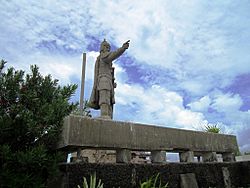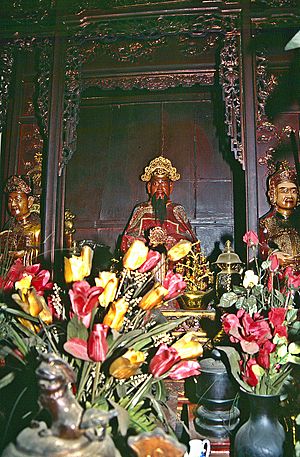Trần Hưng Đạo facts for kids
Quick facts for kids Trần Hưng Đạo |
|||||
|---|---|---|---|---|---|
| Imperial Prince of Đại Việt Grand Prince of Hưng Đạo |
|||||
| Born | 1228 Tức Mặc, Mỹ Lộc, Thiên Trường, Đại Việt (today Nam Định, Vietnam) |
||||
| Died | 1300 (aged 71–72) Vạn Kiếp, Đại Việt (today Chí Linh, Hải Dương Province, Vietnam) |
||||
| Burial | An Lạc garden | ||||
| Spouse | Mother of the Nation Lady Nguyên Từ | ||||
| Issue | Trần Thị Trinh Trần Quốc Nghiễn Trần Quốc Hiện Trần Quốc Tảng |
||||
|
|||||
| House | Trần dynasty | ||||
| Father | Prince Trần Liễu | ||||
| Mother | Mother of the Nation Lady Linh Từ | ||||
| Religion | Buddhism | ||||
| Occupation | Quốc công tiết chế thống lĩnh chư quân (Commander-in-chief of the armies) | ||||
Trần Hưng Đạo (born Trần Quốc Tuấn, 1228–1300) was a famous Vietnamese prince, leader, and military general. He is known as Grand Prince Hưng Đạo (Hưng Đạo Đại Vương). He led the armies of Đại Việt (ancient Vietnam) during the Trần dynasty.
Trần Hưng Đạo is celebrated for successfully defending Đại Việt from two major Mongol invasions in the late 1200s. These victories against the powerful Yuan dynasty (led by Kublai Khan) are considered some of the greatest military achievements in Vietnamese history. After he died, many people in Vietnam began to see him as a god, calling him Đức Thánh Trần.
Contents
Early Life and Family
Trần Hưng Đạo was born as Prince Trần Quốc Tuấn in 1228. His father was Prince Trần Liễu, who was the older brother of Emperor Trần Thái Tông. The Trần family had recently taken over from the Lý family to start the new Trần dynasty in 1225.
Trần Quốc Tuấn, his father, and Emperor Trần Thái Tông were very close. His father made sure he had excellent teachers. He hoped Trần Quốc Tuấn would grow up to be a great leader for Đại Việt. On his deathbed, his father asked him to restore their family's honor.
First Mongol Invasion (1258)
| Trần Hưng Đạo | |
|---|---|
| Vietnamese name | |
| Vietnamese alphabet | Trần Hưng Đạo |
| Chữ Hán | 陳興道 |
During the first Mongol invasion of Đại Việt in 1258, Trần Hưng Đạo was a young officer. He helped command troops defending the border areas.
Second Mongol Invasion (1285)
In 1285, Kublai Khan wanted his Yuan army to pass through Đại Việt to attack the Kingdom of Champa. When Đại Việt refused, the Mongol army, led by Prince Toghan, attacked. They captured the capital city, Thăng Long (modern-day Hanoi).
The emperors, Trần Thánh Tông and Trần Nhân Tông, chose Trần Hưng Đạo to be the Commander-in-chief of all the armies. He first tried to build defenses, but the Mongol forces were very strong. During this time, his loyal helper, Yết Kiêu, saved him from being captured.
Trần Hưng Đạo and Emperor Trần Nhân Tông met and decided to gather a huge army of 200,000 soldiers. They fought a big naval battle against Prince Toghan's fleet. Even though the Yuan fleet won this battle, Trần Hưng Đạo's troops fought hard. They held off the enemy long enough for the emperors and the royal family to escape Thăng Long before it fell.
The Yuan army controlled much of the land, but the Vietnamese leaders escaped to an island. The Mongols struggled with the heat and diseases. This forced them to retreat and wait for cooler weather. The Vietnamese forces then launched strong counterattacks. They were led by Trần Hưng Đạo and other skilled generals, defeating many Yuan commanders.
Third Mongol Invasion (1287)
In 1287, Kublai Khan sent Prince Toghan to lead another, even larger invasion. This time, the Mongol and Chinese forces had a massive army and navy.
At first, the Mongols quickly defeated Vietnamese troops along the border. Prince Toghan's navy also defeated General Trần Khánh Dư's fleet. Meanwhile, another Mongol force captured important military posts.
However, General Trần Khánh Dư regrouped his forces. He ambushed and captured the main Mongol supply fleet at Vân Đồn. This was a huge blow to the Mongols. At the same time, Trần Hưng Đạo recaptured another important area in the north.
With their supplies cut off, the Mongol forces became disorganized. The Vietnamese used guerrilla warfare, attacking the weakened Mongol army and causing heavy losses. Even though the Mongols managed to reach Thăng Long, the emperor ordered the capital to be burned. This prevented the Mongols from taking any valuable resources.
Prince Toghan decided to focus on land battles, where his cavalry was stronger. He sent his naval commander, Omar, to lead the fleet down the Bạch Đằng River.
The Famous Battle of Bạch Đằng River
Trần Hưng Đạo had a brilliant plan for the Bạch Đằng River. Days before the battle, he predicted the Mongol fleet's route. He ordered his soldiers to place heavy wooden stakes with steel tips into the riverbed. These stakes were hidden underwater during high tide.
When Omar's Mongol fleet entered the river, smaller, faster Vietnamese boats lured them further in. As the tide went out, the Mongol ships became stuck on the hidden stakes. Under the watchful eyes of the emperors, Trần Hưng Đạo's forces attacked. They burned about 400 large Mongol ships and captured many sailors. The entire Mongol fleet was destroyed, and their admiral, Omar, was captured.
Prince Toghan's cavalry force tried to escape by land. They were ambushed but managed to retreat in smaller groups. However, many were captured or killed on their way back to China.
Death and Legacy
Trần Hưng Đạo became ill and died peacefully in 1300 AD, at the age of 73. He wished for a simple ceremony. His body was cremated, and his ashes were spread under his favorite oak tree near Thăng Long.
Because of his amazing military skills and his role in defending Đại Việt, the Emperor gave him the special title of Hưng Đạo Đại Vương (Grand Prince Hưng Đạo) after his death.
Family Life
- Father: Prince Yên Sinh
- Mother: Lady Thiện Đạo
- Wife: Princess Thiên Thành
- Children:
- Trần Quốc Nghiễn, also known as Prince Hưng Vũ
- Trần Quốc Hiện, also known as Prince Hưng Trí
- Trần Quốc Tảng, also known as Prince Hưng Nhượng
- Hưng Hiếu vương, also known as Prince Hưng Hiếu
- Trần Thị Trinh, who became Empress Consort Khâm Từ Bảo Thánh to Emperor Trần Nhân Tông
- Empress Tuyên Từ
- Princess Anh Nguyên, who married General Phạm Ngũ Lão
Remembering Trần Hưng Đạo
Places Named After Him
Many cities and towns in Vietnam have streets, areas, and schools named after Trần Hưng Đạo.
- In Hanoi, Tran Hung Dao street is a major road in the south of Hoan Kiem District.
- In Haiphong, Tran Hung Dao road runs along the central park.
- In Da Nang, Tran Hung Dao road is a beautiful waterfront street.
- In Ho Chi Minh City, Tran Hung Dao road is a main street in its Chinatown. There is also a statue of him in the city center.
- In Westminster, CA, a statue honors him. A road there is also called "Đại Lộ Trần Hưng Đạo," which means "Trần Hưng Đạo Boulevard."
Shrines and Beliefs
Trần Hưng Đạo is deeply respected by the Vietnamese people as a national hero. Many shrines are dedicated to him. Some people even believe in him as a god, called Đức Thánh Trần (Tín ngưỡng Đức Thánh Trần).
See also
- Trần dynasty
- History of Vietnam
- Mongol invasions of Vietnam
- Proclamation to the Officers



